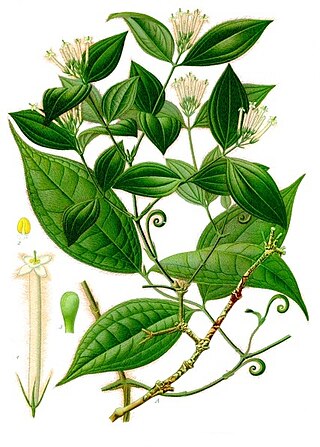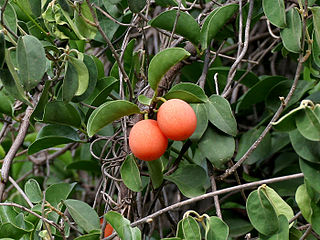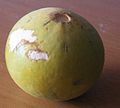
Strychnos nux-vomica, the strychnine tree, also known as nux vomica, poison fruit, semen strychnos, and quaker buttons, is a deciduous tree native to India and to southeast Asia. It is a medium-sized tree in the family Loganiaceae that grows in open habitats. Its leaves are ovate and 5–9 centimetres (2–3.5 in) in size. It is known for being the natural source of the extremely poisonous compound strychnine.

Strychnos is a genus of flowering plants, belonging to the family Loganiaceae. The genus includes about 100 accepted species of trees and lianas, and more than 200 that are as yet unresolved. The genus is widely distributed around the world's tropics and is noted for the presence of poisonous indole alkaloids in the roots, stems and leaves of various species. Among these alkaloids are the well-known and virulent poisons strychnine and curare.

Ziziphus mauritiana, also known as Indian jujube, Indian plum, Chinese date, Chinee apple, ber and dunks is a tropical fruit tree species belonging to the family Rhamnaceae. It is often confused with the closely related Chinese jujube, but whereas Z. jujuba prefers temperate climates, Z. mauritiana is tropical to subtropical.

Ricinodendron is a plant genus in the family Euphorbiaceae first described as a genus in 1864. It includes only one known species, Ricinodendron heudelotii, native to tropical Africa from Senegal + Liberia east to Sudan and Tanzania and south to Mozambique and Angola. It produces an economically important oilseed. The tree is known as munguella (Angola), njangsa (Cameroon), bofeko (Zaire), wama (Ghana), okhuen (Nigeria), kishongo (Uganda), akpi, djansang, essang, ezezang and njasang. Two varieties of the tree species are recognized R. heudelotii var. heudelotii in Ghana and R. heudelotii var. africanum in Nigeria and westwards.

Moringa oleifera is a fast-growing, drought-resistant tree of the family Moringaceae, native to the Indian subcontinent and used extensively in South and Southeast Asia. Common names include moringa, drumstick tree, horseradish tree, or malunggay.

Kigelia is a genus of flowering plants in the family Bignoniaceae. The genus consists of only one species, Kigelia africana, which occurs throughout tropical Africa. The so-called sausage tree grows a poisonous fruit that is up to 60 cm long, weighs about 7 kg, and resembles a sausage in a casing.

Monkey orange is a common name for several trees that produce fruits that are superficially similar to orange (citrus).

Strychnos pungens is a tree which belongs to the Loganiaceae. Usually about 5m tall, occurring in mixed woodland or in rocky places. Branches are short and rigid. Leaves are smooth, stiff, opposite, elliptic and with a sharp, spine-like tip. Occurring in South Africa on the Witwatersrand, Magaliesberg and further north to northern Namibia, northern Botswana and Zimbabwe.

Ximenia americana, commonly known as tallow wood, hog plum, yellow plum, sea lemon, or pi'ut (Chamorro), is bush-forming shrub/small tree; a species from the Ximenia genus in the Olacaceae family. It is mainly found in the tropics, ranging from Africa, India and southeast Asia, to Australia, New Zealand, Pacific Islands, West Indies, Central, North and South America. It is especially common in Africa and South America. It is not domesticated so it is only found occurring in the wild.

Uapaca kirkiana, the sugar plum or mahobohobo, is a species of dioecious plant in the family Phyllanthaceae. It is native to the southern Afrotropics, where it occurs in well-watered miombo woodlands. Within range it is one of the most popular wild fruits. It is rarely cultivated but trees are left when land is being cleared. Still a traditional food plant in Africa, this little-known fruit has the potential to improve nutrition, boost food security, foster rural development and support sustainable land care.

Balanites aegyptiaca is a species of tree, classified as a member of either the Zygophyllaceae or the Balanitaceae. This tree is native to much of Africa and parts of the Middle East.

Flacourtia indica (known commonly as ramontchi, governor's plum and Indian plum, is a species of flowering plant native to much of Africa and tropical and temperate parts of Asia. It has various uses including, folk medicine, fuel, animal food and human food.

Treculia africana is a tree species in the genus Treculia which can be used as a food plant and for various other traditional uses. The fruits are hard and fibrous, can be the size of a volleyball and weight up to 8.5 kg (19 lb). Chimpanzees have been observed to use tools to break the fruits into small pieces that they can eat. The fruits contain polyphenols.

Cordia sinensis is a species of flowering tree in the borage family, Boraginaceae. The species’ range extend from South Africa, through East Africa, Madagascar, West Africa and the Middle East to the Indian Subcontinent and Eastern Indochina. There is also a disjunct native population in Senegal. The species has become naturalised in Eastern Australia. Common names include grey-leaved saucer berry, grey-leaved cordia, marer, mnya mate, mkamasi and tadana.

Croton gratissimus, is a tropical African shrub or small tree with corky bark, growing to 8 m and belonging to the family of Euphorbiaceae or spurges. Young twigs are slender and angular and covered in silver and rust-coloured scales.

Pappea capensis is a South African tree in the family Sapindaceae. It is the only species in the genus Pappea.

Telfairia pedata, commonly known as oysternut, queen's nut, Zanzibar oilvine, kweme or kulekula, is a dioecious African liana which can grow up to 30 metres long, having purple-pink fringed flowers, and very large, many-seeded, drooping, ellipsoid berries which can weigh up to 15 kg. It is valuable for having edible fruit, seeds and oil.

Strychnos madagascariensis, the black monkey orange, is an African tropical and sub-tropical tree belonging to the Loganiaceae family. It is a tree with characteristically large fruit but can confused with some other species of the genus.

Landolphia is a genus of flowering plants in the family Apocynaceae first described as a genus in 1806. They take the form of vines that scramble over host trees. Landolphia is native to tropical Africa.

Raphia farinifera is a tropical African palm tree occurring in lowland riparian and swamp forest, also around human habitations and cultivated locations, on stream banks and other moist situations at altitudes of 50–1000 m. Found in Angola, Benin, Burkina, Cameroon, Gambia, Ghana, Guinea, Ivory Coast, Kenya, Madagascar, Malawi, Mauritius, Mozambique, Nigeria, Réunion, Senegal, Seychelles, Sierra Leone, Tanzania, Togo, Uganda, Zambia and Zimbabwe, and naturalised in east lowlands of Madagascar. Its generic epithet is derived from raphis = 'needle', probably in reference to the 4 mm long yellowish spines on the margins and main veins of the leaflets. The specific name refers to a type of starchy flour obtained from the trunk pith – farina = 'starch', fera = 'bearing'.





















